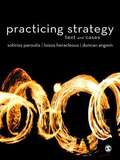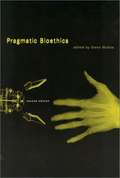- Table View
- List View
Practical Financial Management
by William R. LasherThe author William R. Lasher captivates readers with unique insights into the issues and challenges facing financial managers every day. rom a look at hidden agendas and the biases of decision makers in the firm to the analyses of financial proposals, Lasher's practical, relevant presentation keep students reading. This edition examines the latest financial developments, including the financial crisis of 2008-2009. You will find an engaging, complete presentation perfectly matched to the needs of today's business students, from the use of everyday math, rather than advanced math in theory sections, to numerous worked-out examples and graphical and intuitive presentations.
Practical Healthcare Epidemiology
by Ebbing Lautenbach Keith F. Woeltje Preeti N. MalaniIn recent years, issues of infection prevention and control, patient safety, and quality-of-care have become increasingly prominent in healthcare facilities. Practical Healthcare Epidemiology takes a practical, hands-on approach to these issues, addressing all aspects of infection surveillance and prevention in clear, straightforward terms. This fully revised third edition brings together the expertise of more than fifty leaders in healthcare epidemiology who provide clear, sound guidance on infection prevention and control for the full range of patients in all types of healthcare facilities, including those in settings with limited resources. A powerful resource for practitioners in any branch of medicine or public health who are involved in infection prevention and control, whether they are experienced in healthcare epidemiology or new to the field. "A handy desk reference and an up-to-date primer for trainees and experts alike" --The Journal of the American Medical Association "An essential for anyone in the field. "--Thomas R. Talbot, Chief Hospital Epidemiologist, Vanderbilt University Medical Center
Practical Healthcare Epidemiology (3rd edition)
by Ebbing Lautenbach Keith Woeltje Preeti MalaniIn recent years, issues of infection prevention and control, patient safety, and quality-of-care have become increasingly prominent in healthcare facilities. Practical Healthcare Epidemiology takes a practical, hands-on approach to these issues, addressing all aspects of infection surveillance and prevention in clear, straightforward terms. This fully revised third edition brings together the expertise of more than fifty leaders in healthcare epidemiology who provide clear, sound guidance on infection prevention and control for the full range of patients in all types of healthcare facilities, including those in settings with limited resources. A powerful resource for practitioners in any branch of medicine or public health who are involved in infection prevention and control, whether they are experienced in healthcare epidemiology or new to the field. "A handy desk reference and an up-to-date primer for trainees and experts alike" --The Journal of the American Medical Association "An essential for anyone in the field. "--Thomas R. Talbot, Chief Hospital Epidemiologist, Vanderbilt University Medical Center
Practical Horticulture (5th edition)
by Laura Williams Rice Robert P. RiceA textbook for a course in horticultural design for non-majors, and a reference for both amateur and professional ornamental gardeners. Explains the fundamentals of horticulture and techniques for growing plants inside and outside. Updated from the 1993 edition (first in 1986) with new photographs and bibliographical references, and new information on floral arrangements and pesticides. Annotation c. by Book News, Inc., Portland, Or.
Practical Law Office Management (3rd Edition)
by Brent RoperPractical Law Office Management, third edition focuses on law office management from a practical standpoint. Designed for the paralegal student interested in day-to-day law office management topics, this text focuses on client relations and communication skills; legal fees, timekeeping, and billing, client trust funds and law office accounting; calendaring, docket control, and case management; legal marketing; and file and law library management. This revised edition offers an extended focus on technology, including a full demonstration of Thomson's ProLaw software and in-depth software tutorials. It includes up-to-date charts and graphs that present material in an easy-to-understand context. Each chapter now includes thought-provoking questions, and expanded and interesting case studies that deal with unique facts specific to practicing paralegals appear after most chapters. To expand the technology focus of the text, Excel exercises appear in the timekeeping and billing and trust account chapters. In addition, this revised text has a strong ethics focus throughout, with ethics-related cases included at the end of nearly every chapter.
Practical Logic: An Antidote for Uncritical Thinking (5th edition)
by Douglas J. Soccio Vincent E. BarryThe Fifth Edition of PRACTICAL LOGIC continues its tradition as a breakthrough introductory text by de-emphasizing symbolic logic and scientific method, instead presenting the practical aspects of logic and critical thinking. The text does not mistake technical apparatus (charts, decision trees, and models) for clarity, and consequently does not burden students with confusing and unnecessary barriers to critical assessment of arguments and claims. PRACTICAL LOGIC combines clear writing and a wealth of everyday examples to make logic accessible and relevant to the beginning student. Logic and critical thinking are even easier to understand in this streamlined new edition. With its clear language and interesting, realistic examples, students learn to recognize clear arguments and to employ critical thinking in all areas of study. Full treatment of knowledge claims (epistemology) addresses issues of expertise, authority, and relativity. Over 1200 exercises include open-ended discussion questions as well as standard exercises that help students review and assimilate concepts.
Practical Newspaper Reporting (Media Manuals Ser.)
by Geoffrey Harris David B. SparkNow in its fourth edition, this classic textbook has grown up alongside the newspaper industry. Today, as ever, it provides students of newspaper journalism with a toolkit for gathering news and filling ever-increasing space with first-rate copy for print and online. Detailed and down-to-earth, this book delivers: * Guidance on news gathering, from government and business to sport and religion * Guidance on news writing, drawing on over 300 examples that have appeared in print, discussing why they work or how they could have been better * Guidance on feature writing, including profiles, comment, leading articles, obituaries and reviews * Specific chapters on ethical reporting and the possibilities and pitfalls of investigative journalism * A review of the new financial realities that the internet is imposing on the media. Informed by over half a century's professional experience and fully revised to give a nuanced account of the skills required in an online environment, this book is an essential companion for your journalism degree and beyond.
Practical Rules for Cursed Witches
by Kayla CottinghamFrom the New York Times bestselling author of My Dearest Darkest comes a cozy fantasy romance about a teen witch who must complete her magical training by breaking a powerful family&’s curse. But her own affliction—to never find true love—gets in the way when she falls for the girl she&’s trying to save.Magic is in Delilah Bea&’s blood. Her absentee father is the world&’s most famous cursebreaker, while all the women in her family are fated to never find true love. So when Delilah sets out to complete her magical Calling and gain her full powers as a witch, she has the perfect task in mind—breaking the Bea family curse.But Delilah&’s Calling is hijacked by Kieran Pelumbra, the spoiled son of the most powerful family in the country, and breaking his curse suddenly becomes her official assignment. Every generation, a pair of Pelumbra twins is doomed, with one twin draining the other of their life and magic. Kieran grows weaker while his sister, Briar, becomes…something monstrous. As Delilah and the twins set out on their quest, they quickly realize that breaking the Pelumbra curse isn&’t going to be simple. For one thing, the rest of the Pelumbra family doesn&’t actually want their curse broken—and they&’ve sent hunters after the trio to ensure they fail. For another, something about Briar gets under Delilah&’s skin, distracting her and making her want to kiss the perpetually grumpy look off her face. But with time running out for the twins and Delilah&’s own true love curse getting in the way, they may not stand a chance of finding their happily ever after.
Practice makes permanent: 300+ questions for AQA GCSE Biology
by Jo OrmisherPractise and prepare for AQA GCSE Biology with hundreds of topic-based questions and one complete set of exam practice papers designed to strengthen knowledge and prepare students for the exams.This extensive practice book raises students' performance by providing 'shed loads of practice', following the 'SLOP' learning approach that's recommended by teachers.- Consolidate knowledge and understanding with practice questions for every topic and type of question, including multiple-choice, multi-step calculations and extended response questions.- Develop the mathematical, literacy and practical skills required for the exams; each question indicates in the margin which skills are being tested.- Confidently approach the exam having completed one set of exam-style practice papers that replicate the types, wording and structure of the questions students will face.- Identify topics and skills for revision, using the page references in the margin to refer back to the specification and accompanying Hodder Education Student Books for remediation.- Easily check answers with fully worked solutions and mark schemes provided in the book.
Practice makes permanent: 350+ questions for AQA GCSE Chemistry
by Sam Holyman Owen MansfieldPractise and prepare for AQA GCSE Chemistry with hundreds of topic-based questions and one complete set of exam practice papers designed to strengthen knowledge and prepare students for the exams.This extensive practice book raises students' performance by providing 'shed loads of practice', following the 'SLOP' learning approach that's recommended by teachers.- Consolidate knowledge and understanding with practice questions for every topic and type of question, including multiple-choice, multi-step calculations and extended response questions.- Develop the mathematical, literacy and practical skills required for the exams; each question indicates in the margin which skills are being tested.- Confidently approach the exam having completed one set of exam-style practice papers that replicate the types, wording and structure of the questions students will face.- Identify topics and skills for revision, using the page references in the margin to refer back to the specification and accompanying Hodder Education Student Books for remediation.- Easily check answers with fully worked solutions and mark schemes provided in the book.
Practice makes permanent: 350+ questions for AQA GCSE Physics
by Darren Forbes Kimberley WalrondPractise and prepare for AQA GCSE Physics with hundreds of topic-based questions and one complete set of exam practice papers designed to strengthen knowledge and prepare students for the exams.This extensive practice book raises students' performance by providing 'shed loads of practice', following the 'SLOP' learning approach that's recommended by teachers.- Consolidate knowledge and understanding with practice questions for every topic and type of question, including multiple-choice, multi-step calculations and extended response questions.- Develop the mathematical, literacy and practical skills required for the exams; each question indicates in the margin which skills are being tested.- Confidently approach the exam having completed one set of exam-style practice papers that replicate the types, wording and structure of the questions students will face.- Identify topics and skills for revision, using the page references in the margin to refer back to the specification and accompanying Hodder Education Student Books for remediation.- Easily check answers with fully worked solutions and mark schemes provided in the book.
Practice makes permanent: 400+ questions for AQA A-level Biology
by Pauline Lowrie Ariadne BakerPractise and prepare for AQA A-level Biology with hundreds of topic-based questions and one complete set of exam practice papers designed to strengthen knowledge and prepare students for the exams.This extensive practice book raises students' performance by providing 'shed loads of practice', following the 'SLOP' learning approach that's recommended by teachers.- Consolidate knowledge and understanding with practice questions for every topic and type of question, including multiple-choice, multi-step calculations and extended response questions.- Develop the mathematical, literacy and practical skills required for the exams; each question indicates in the margin which skills are being tested.- Confidently approach the exam having completed one set of exam-style practice papers that replicate the types, wording and structure of the questions students will face.- Identify topics and skills for revision, using the page references in the margin to refer back to the specification and accompanying Hodder Education Student Books for remediation.- Easily check answers with fully worked solutions and mark schemes provided in the book.
Practice makes permanent: 450+ questions for AQA A-level Physics
by James Irvine Alessio BernardelliPractise and prepare for AQA A-level Physics with hundreds of topic-based questions and one complete set of exam practice papers designed to strengthen knowledge and prepare students for the exams.This extensive practice book raises students' performance by providing 'shed loads of practice', following the 'SLOP' learning approach that's recommended by teachers.- Consolidate knowledge and understanding with practice questions for every topic and type of question, including multiple-choice, multi-step calculations and extended response questions.- Develop the mathematical, literacy and practical skills required for the exams; each question indicates in the margin which skills are being tested.- Confidently approach the exam having completed one set of exam-style practice papers that replicate the types, wording and structure of the questions students will face.- Identify topics and skills for revision, using the page references in the margin to refer back to the specification and accompanying Hodder Education Student Books for remediation.- Easily check answers with fully worked solutions and mark schemes provided in the book.
Practice makes permanent: 600+ questions for AQA A-level Chemistry
by Nora Henry Alyn G. McFarlandPractise and prepare for AQA A-level Chemistry with hundreds of topic-based questions and one complete set of exam practice papers designed to strengthen knowledge and prepare students for the exams.This extensive practice book raises students' performance by providing 'shed loads of practice', following the 'SLOP' learning approach that's recommended by teachers.- Consolidate knowledge and understanding with practice questions for every topic and type of question, including multiple-choice, multi-step calculations and extended response questions.- Develop the mathematical, literacy and practical skills required for the exams; each question indicates in the margin which skills are being tested.- Confidently approach the exam having completed one set of exam-style practice papers that replicate the types, wording and structure of the questions students will face.- Identify topics and skills for revision, using the page references in the margin to refer back to the specification and accompanying Hodder Education Student Books for remediation.- Easily check answers with fully worked solutions and mark schemes provided in the book.
Practice makes permanent: 600+ questions for AQA GCSE Combined Science Trilogy
by Sam Holyman Jo Ormisher Darren Forbes Owen Mansfield Kimberley WalrondPractise and prepare for AQA GCSE Combined Science with hundreds of topic-based questions and one complete set of exam practice papers designed to strengthen knowledge and prepare students for the exams.This extensive practice book raises students' performance by providing 'shed loads of practice', following the 'SLOP' learning approach that's recommended by teachers.- Consolidate knowledge and understanding with practice questions for every topic and type of question, including multiple-choice, multi-step calculations and extended response questions.- Develop the mathematical, literacy and practical skills required for the exams; each question indicates in the margin which skills are being tested.- Confidently approach the exam having completed one set of exam-style practice papers that replicate the types, wording and structure of the questions students will face.- Identify topics and skills for revision, using the page references in the margin to refer back to the specification and accompanying Hodder Education Student Books for remediation.- Easily check answers with fully worked solutions and mark schemes provided in the book.
Practicing Protestants: Histories of Christian Life in America, 1630–1965 (Lived Religions)
by Leigh E. Schmidt Mark Valeri Laurie F. Maffly - KippThis collection of essays explores the significance of practice in understanding American Protestant life. The authors are historians of American religion, practical theologians, and pastors and were the twelve principal researchers in a three-year collaborative project sponsored by the Lilly Endowment. Profiling practices that range from Puritan devotional writing to twentieth-century prayer, from missionary tactics to African American ritual performance, these essays provide a unique historical perspective on how Protestants have lived their faith within and outside of the church and how practice has formed their identities and beliefs. Each chapter focuses on a different practice within a particular social and cultural context. The essays explore transformations in American religious culture from Puritan to Evangelical and Enlightenment sensibilities in New England, issues of mission, nationalism, and American empire in the nineteenth and twentieth centuries, devotional practices in the flux of modern intellectual predicaments, and the claims of late-twentieth-century liberal Protestant pluralism. Breaking new ground in ritual studies and cultural history, Practicing Protestants offers a distinctive history of American Protestant practice.
Practicing Strategy
by Loizos Heracleous Duncan Angwin Sotirios Paroutis*Shortlisted for the CMI Management Book of the Year*<P><P> Practicing Strategy is a groundbreaking new textbook focusing on the strategy-as-practice approach, which considers strategy not only as something an organisation has but something which its members do.<P> By bringing together a number of distinctive investigations of strategy practice, this book will enrich your understanding of the dynamic process through which organizational strategies are created and executed.<P> Key features:<P> * The first textbook to be based on insights from the strategy-as-practice perspective, making it an ideal core text for related modules <P> * Packed with real-life mini case studies and a final section containing longer cases from Apple, Centrica, Marconi, Lafarge and Wikimedia, relating theory to practice <P> * Chapters include learning objectives, summaries, discussion questions and further readings and a Companion Website contains additional online readings, to consolidate your learning and encourage in-depth analysis. <P> Practicing strategy is an invaluable text for undergraduate and postgraduate students of advanced strategy modules. <P> Visit the Companion Website at www.sagepub.co.uk/paroutis
Practicing Texas Politics (15th Edition)
by Lyle Brown Robert E. Biles Sonia R. Garcia Joyce A. Langenegger Ted A. LewisNew information about policymaking and analysis about politics in the Lone Star State is written by top Texas politics scholars.
Practitioner Research for Social Work, Nursing, and the Health Professions
by Michael T. Wright Payam Sheikhattari Gillian B. Silver Cyrilla van der Donk Bas van LanenAn invaluable tool for health and social work students and professionals who want to improve their practice through collaborative research with patients, clients, and colleagues.Throughout history, some of the most prominent contributors to health and social sciences have been men and women comfortable with both practice and academia. But today, research in health-related fields is increasingly conducted in specialized settings by people who are first and foremost researchers. Critics bemoan this loss of practice-based research, long considered a vital part of the contribution that doctors, nurses, public health workers, and social workers can make both to their field and the communities in which they work. Unfortunately, the explosion of new discoveries in health-related fields, along with the exponential increase in the amount of knowledge being produced and the growing demands of practice, have caused both the production and application of knowledge to become highly specialized and increasingly complex. This has resulted in a widening gap between research and practice.Recognizing the need for a guide to this type of research, Practitioner Research for Social Work, Nursing, and the Health Professions is a thoroughly reimagined version of a book originally published in 2011 in the Netherlands. Aimed at American practitioners, it is a highly practical guide for anyone in social work, nursing, and other health care and social welfare settings. Its seven-step Practitioner Research Method offers readers a tried-and-true approach to conducting research in their own work environments, and the authors use real-world examples to highlight strategies for overcoming barriers and incorporating research.While leading practitioners through each stage of the research process, the authors explain in detail how to apply a variety of field-tested tools and techniques. A unique and indispensable resource for students in undergraduate and graduate research courses, as well as for seasoned professionals who seek a practical guide for developing and implementing their own research projects in social work, nursing, and the health professions, this book is also the first textbook to introduce the concept and practice of practitioner research to an American audience.
Pragmatic Bioethics (Second Edition)
by Glenn McgeeModern scientific and medical advances bring new complexity and urgency to ethical issues in health care and biomedical research. This book applies the American philosophical theory of pragmatism to such bioethics. Critics of pragmatism argue that it lacks a universal moral foundation. Yet it is this very lack of a metaphysical dividing line between facts and values that makes pragmatism such a rigorous and appropriate method for solving problems in bioethics. For pragmatism, ethics is a way of satisfying the complex demands of multiple individuals and groups in a contingent and changing world. Pragmatism also demands careful attention to the ways in which scientific advances change our values and ethics. The essays in this book present different approaches to pragmatism and different ways of applying pragmatism to scientific and medical matters. They use pragmatism to guide thinking about such timely topics as stem cell research, human cloning, genetic testing, human enhancement, and care for the poor and aging. This new edition contains three new chapters, on difficulties with applying pragmatism to law and bioethics, on helping people to die, and on embryonic stem cell research.
Prealgebra
by Terry A. Krieger Gary K. RockswoldThe Rockswold/Krieger algebra series fosters conceptual understanding by using relevant applications and visualization to show students why math matters. It answers the common question "When will I ever use this?" Rockswold teaches students the math in context, rather than including the applications at the end of the presentation. By seamlessly integrating meaningful applications that include real data and supporting visuals (graphs, tables, charts, colors, and diagrams), students are able to see how math impacts their lives as they learn the concepts. The authors believe this approach deepens conceptual understanding and better prepares students for future math courses and life.
Prebles' Artforms
by Duane Preble Sarah Preble Patrick L. FrankPrebles' Artforms continues to lead the field with its steadfast focus on contemporary art, global artists, and cutting edge technology for the art appreciation classroom. We form Art. Art forms us. The title of this book has a dual meaning. Besides the expected discussion of the various forms of art, the title also reflects the fact that art does indeed help to form us as people. As we create forms, we are in turn formed by what we have created. Several years ago, the title was changed to Prebles' Artforms, acknowledging the pioneering contribution of the original authors, Duane and Sarah Preble, to the study of art. Their vision and spirit have touched hundreds of thousands of students who have studied this book. Artforms grew out of a desire to introduce art through an engaging visual experience, and to expose students to a culturally diverse canon of work. It is written and designed to help readers build an informed foundation for individual understanding and enjoyment of art. By introducing art theory, practice, and history in a single volume, this book aims to draw students into a new or expanded awareness of the visual arts. Beyond fostering appreciation of major works of art, this book's primary concern is to open students' eyes and minds to the richness of the visual arts as unique forms of human communication and to convey the idea that the arts enrich life best when we experience, understand, and enjoy them as integral parts of the process of living.
Precalculus
by Bernard Kolman Arnold Shapiro Michael L LevitanPrecalculus: A mathematics/statistics textbook
Precalculus (9th Edition)
by Michael SullivanMike Sullivan's time-tested approach focuses students on the fundamental skills they need for the course: preparing for class, practicing with homework, and reviewing the concepts. In the Ninth Edition, Precalculus has evolved to meet today's course needs, building on these hallmarks by integrating projects and other interactive learning tools for use in the classroom or online.
Precalculus With Unit-circle Trigonometry
by David CohenIn this new ADVANTAGE SERIES version of David Cohen's PRECALCULUS: WITH UNIT CIRCLE TRIGONOMETRY, THIRD EDITION, Cohen continues to offer a book that is accessible to the student through a careful progression and presentation of concepts, rich problem sets and examples to help explain and motivate concepts, and continual guidance through the challenging work needed to master concepts and skills. This book is identical to PRECALCULUS: A PROBLEMS-ORIENTED APPROACH, Fifth Edition with the exception of the first four chapters on trigonometry. As part of the ADVANTAGE SERIES, this new version will offer all the quality content you've come to expect from Cohen sold to your students at a significantly lower price.
























